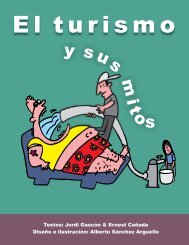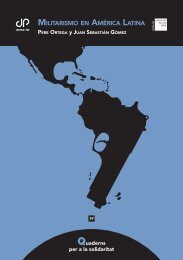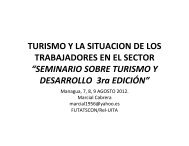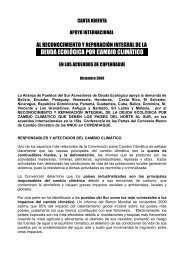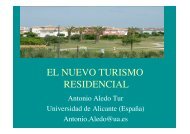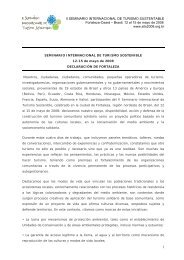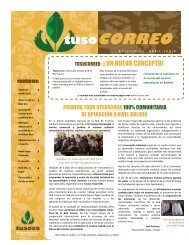Beyond Greening - Tourism Watch
Beyond Greening - Tourism Watch
Beyond Greening - Tourism Watch
You also want an ePaper? Increase the reach of your titles
YUMPU automatically turns print PDFs into web optimized ePapers that Google loves.
<strong>Beyond</strong> <strong>Greening</strong>: Reflections on <strong>Tourism</strong> in the Rio-Process | Positioningpapercultural facilitator between two worlds that have a mutual need for one another. In a foodsovereignty strategy, weaving together synergies of this kind is fundamental.From another perspective, the consolidation of a rural world in which peasant familiespredominate with better conditions and greater life expectancy leads to positive effects ofanother kind on a global scale, from which society as a whole can benefit. This is a ruralpopulation that produces food for the local and national market, providing water, creatingspaces for collective memory, and caring for and conserving the natural environment, amongother aspects.<strong>Tourism</strong> in the hands of rural populationsThe ways in which this kind of tourism in the hands of rural populations is organised variesenormously, depending on the context and the historical characteristics of the communityorganisation of each place. In some countries in Latin America, there has been apredominance of community tourism or family-based peasant initiatives.In each place, rural populations that are territorially connected in both productive andcultural terms must find ways to organise themselves and form alliances that best suit theirinterests. In this process, it would be desirable for peasant organisations not to lose sight of theneed to strengthen “proximity tourism” with less energy consumption than air and longdistancetransport. Successful experiences such as the Cerrato Brothers’ finca in Estelí inNicaragua, among many others, show the possibilities of a community tourism model basedmainly on a national clientele that lives in the same area (less than an hour from the closesturban centre in this case). The finca combines a varied range of organically produced food andornamental plants, with livestock and dairy products as well as tourist services.The offer should also take into account the average economic capacity of the nationalpopulation, and avoid a kind of elite rural tourism, catering only to tourists with greaterpurchasing power. In El Salvador, for example, community initiatives such as the CinqueraForest and the Peace Route show the potential of tourism geared toward low- and middleincomesegments of society.The growing trend of global "touristisation" which is also occurring in many rural areas thatare directly or indirectly affected by this activity requires a greater reflection of the tourismphenomenon under the angle of food sovereignty. Every day it becomes harder not to taketourism into account as a key factor in redefining rurality. Securing a greater degree of controlfor rural populations over their territories and resources, including in terms of tourism, is afundamental challenge.References:Girardi Stellin, Monsignor Victorino (2009): “Carta Pastoral. Discípulos, tras las huellas de Cristo,promoviendo la vida en Él, al Norte de Costa Rica”, Diocese of Tilarán-Liberia, Costa Rica, 19/7/2009United Nations (2009): Report by the Independent Expert on the Issue of Human Rights ObligationsRelated to Access to Safe Drinking Water and Sanitation, Catarina de Alburquerque,A/HRC/12/24/Add.1, 23/6/2009Ernest Cañada is coordinator of the Catalan organisation Alba Sud – Investigation and Communicationfor Development, and member of the Group to Research Sustainability and Territory (GIST) at theUniversity of the Balearic Islands.English translation: Centro Superior de Idiomas de la Universidad de Alicante, S.A.U.41



